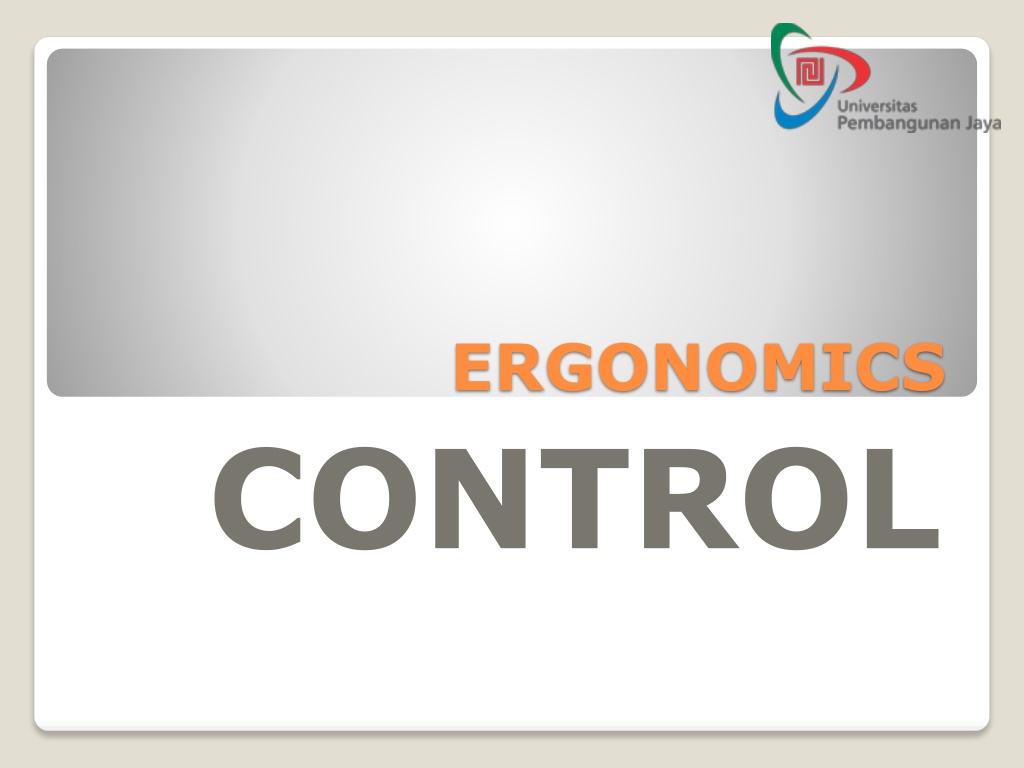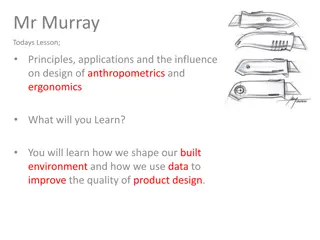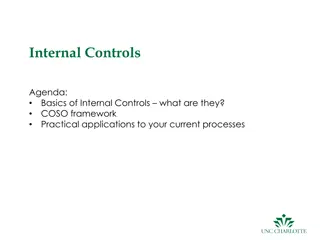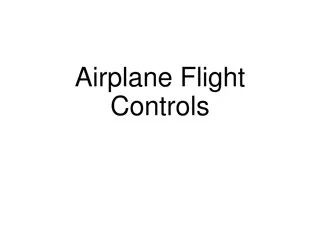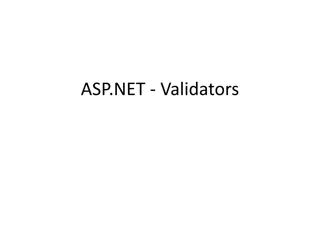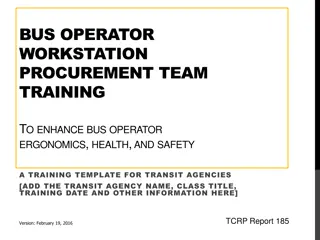Understanding Controls in Ergonomics
Controls in ergonomics are devices enabling communication and manipulation of objects, enhancing power, reach, and reducing effort and risk. They transmit information discretely or continuously through hand push buttons, foot push buttons, toggle switches, rotary selector switches, knobs, cranks, wheels, levers, and pedals. Control compatibility and the use of force are crucial considerations in design, ensuring ease of operation within operator capabilities. Differentiation in controls through shape, size, and coding improves identification and usability, enhancing user experience in various applications.
Uploaded on Sep 10, 2024 | 0 Views
Download Presentation

Please find below an Image/Link to download the presentation.
The content on the website is provided AS IS for your information and personal use only. It may not be sold, licensed, or shared on other websites without obtaining consent from the author. Download presentation by click this link. If you encounter any issues during the download, it is possible that the publisher has removed the file from their server.
E N D
Presentation Transcript
ERGONOMICS CONTROL
A control is a device that allows you to 'communicate' with objects and to manipulate them. Controls can enable you to direct equipment or machinery that can help you to generate more power, more reach and to reduce effort and risk. In some cases, the control also provides the force to make an action happen, for example, a foot pump pedal. What is a control?
The type of information that is transmitted by a control can be discrete (separate) or continuous. Discrete controls use a limited number of conditions, for example, a light switch, which is either on or off. Continuous controls use any value between the outer limits, for example, the gas control knob on a cooker hob can regulate the flow of gas anywhere between the minimum and maximum flows. Types of controls
Hand push button Foot push button Toggle switch Rotary selector switch DISCRETE CONTROLS
Knob Crank Wheel Lever Pedal CONTINUOUS CONTROLS
Control compatibility The control should operate in the way that people expect it to operate. There are certain directions of control movement which are expected by the majority of people. They are called population stereotypes and control movements which conform to these stereotypes are said to be compatible. In western Europe, for example, a movement to the right, a movement forwards and away from the body, or a clockwise rotation, instinctively suggests a start or increase in operation. Guidelines for design
The use of force The maximum force (and speed, accuracy, or range of body movement) required to operate a control should not exceed the limits of the least capable operator. 'Normal' requirements for control operation should be a lot less than the capabilities of most operators. Control movements should be as short as possible.
Controls that are different (coded) in terms of either shape, size, mode of operation, labelling, or colour are easier to identify than controls which are similar in these respects. Shape coding - the use of a distinctive shape for controls improves their visual and tactile (touch) identification. Standardised shapes should be used and sharp edges should be avoided on the parts of the control that are grasped. Size coding - where size is used to distinguish controls (usually control knobs), the larger control should always be at least 20% larger than the smaller one for controls ranging from 15-150mm in diameter, in order to avoid confusion in selection. Colour coding - colour should not be used as the sole method of coding of the control. It is more effective when combined with other methods. Use red, orange, yellow, green and blue as they are the only colours that are effectively identified and recognised. However about 7% of men and under 1% of women suffer from red-green colour blindness - they are unable to differentiate reds and greens and tend to see these colours as shades of greyish-yellow. Therefore, in situations where colour coding and recognition are vital, you should check that all operators can distinguish the colours used. Coding of controls
If controls are to be labelled, adequate space and lighting must be provided to enable the labels to be clearly visible. Labels should be either on the control or immediately adjacent to it. They should not obscure the control and should be difficult to remove. Letters and numbers used should be standard. Labelling
You should use hand controls in preference to foot controls if: - accuracy of control positioning is important; - speed of control positioning is important; - continuous or prolonged application of force is not necessary. You should use: Push buttons or toggle switches for tasks involving speed of operation. Fingertip or hand-operated rotary knobs for fine adjustment and small forces, e.g. radio tuning. Control sticks or levers when you need to apply moderate to large forces intermittently, e.g. gear changing or using the hand brake in a car. Sticks, levers or wheels for continuous adjustment or tracking tasks. Controls that use one handed operation for precision and speed. Controls that use two handed operation for larger forces. Hand controls
You should use foot controls in preference to hand controls if: - continuous control of the task is required but the precision of the position of the control is not important. - large forces need to be applied. If a large force is needed, you should use a pedal on which pressure is applied by the whole leg, e.g. car brake pedal. If a smaller force and continuous control is needed, you should use a pedal on which pressure is applied mainly from the ankle, e.g. car accelerator pedal. For all foot controls, the direction of movement should be down or away from the body and in line with the centre of the body. The angle at which the pedal is positioned should allow the foot to be placed on the pedal surface with the ankle at an angle of 90 . This angle should increase with operation of the pedal, that is, the pedal should be pushed away from the body to operate. A pedal should be flat and have a large enough contact area so that the foot does not slip off (a width of at least 90mm). A textured surface also helps to keep the foot in position. Foot controls should only be used if you are seated, or for very short standing times. It can place strain on the other leg/foot if you operate a foot pedal while standing. Foot controls
Suitability for tasks involving: Control type Speed Accuracy Force Range Push button Good Unsuitable Unsuitable Unsuitable Toggle switch Good Unsuitable Unsuitable Unsuitable Rotary selector Good Good Unsuitable Unsuitable Knob Unsuitable Fair Unsuitable Fair Small crank Good Poor Unsuitable Good Large crank Poor Unsuitable Good Good Wheel Poor Good Fair/Poor Fair Horizontal lever Good Poor Poor Poor Vertical lever (to/from body) Short: Poor Long: Good Good Fair Poor Vertical lever (across body) Fair Fair Fair Unsuitable Joystick (lever) Good Good Poor Unsuitable Pedal Good Poor Good Unsuitable Choosing a control
